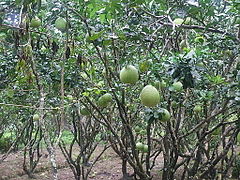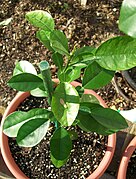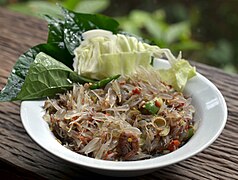| Revision as of 15:31, 28 October 2024 editChiswick Chap (talk | contribs)Autopatrolled, Extended confirmed users, Page movers, New page reviewers, Pending changes reviewers, Rollbackers297,717 edits →History: wl caption← Previous edit | Revision as of 15:37, 28 October 2024 edit undoChiswick Chap (talk | contribs)Autopatrolled, Extended confirmed users, Page movers, New page reviewers, Pending changes reviewers, Rollbackers297,717 edits merge s/sections; I'm afraid that list is a terrible uncited mess, 2/3 off-topic for this article, so we're better off without itNext edit → | ||
| Line 38: | Line 38: | ||
| ]'' species including the ] and the ].<ref name="Wu Terol Ibanez 2018"/>]] | ]'' species including the ] and the ].<ref name="Wu Terol Ibanez 2018"/>]] | ||
| ⚫ | === Hybrids === | ||
| ⚫ | {{further|Citrus taxonomy}} | ||
| ⚫ | The pomelo is one of the original citrus species from which cultivated citrus fruits have been ], others being ], ], and to a lesser extent, ] and ]. In particular, the ] is presumed to be a naturally occurring hybrid between the pomelo and the mandarin, with the pomelo as larger and firmer of the two. The grapefruit was originally also presumed to be a naturally occurring hybrid of the pomelo and the mandarin; however, genome analysis conducted more than two centuries after this presumption was made shows that it is actually a backcrossed hybrid between a pomelo and a ], a pomelo × mandarin hybrid, which is why 63% of the grapefruit's genome comes from the pomelo.<ref>{{cite journal |url=https://journals.ashs.org/horttech/view/journals/horttech/aop/article-10.21273-HORTTECH04679-20/article-10.21273-HORTTECH04679-20.xml |title=Grapefruit: History, Use, and Breeding in: HortTechnology Volume 31 Issue 3 (2021) |journal=Horttechnology |publisher=Journals.ashs.org |date=June 2021|volume=31 |issue=3 |pages=243–258 |doi=10.21273/HORTTECH04679-20 |accessdate=2022-05-01 |last1=Louzada |first1=Eliezer S. |last2=Ramadugu |first2=Chandrika |doi-access=free }}</ref> | ||
| === Etymology === | === Etymology === | ||
| Line 43: | Line 49: | ||
| According to the ], the etymology of the word "pomelo" is uncertain.<ref>{{Cite OED|pomelo|id=147483}}</ref> It may be derived from Dutch ''pompelmoes''.<ref name=morton1/> Its botanical name, ''Citrus maxima'', means "the biggest citrus". In English, the word "pomelo" (also spelt '''pummelo''', '''pumelo''', '''pomello''', '''pommelo''') has become the more common name, although "pomelo" has historically been used for ]. | According to the ], the etymology of the word "pomelo" is uncertain.<ref>{{Cite OED|pomelo|id=147483}}</ref> It may be derived from Dutch ''pompelmoes''.<ref name=morton1/> Its botanical name, ''Citrus maxima'', means "the biggest citrus". In English, the word "pomelo" (also spelt '''pummelo''', '''pumelo''', '''pomello''', '''pommelo''') has become the more common name, although "pomelo" has historically been used for ]. | ||
| One theory is that after introduction into ] by a 'Captain Shaddock' of the ] (apparently Philip Chaddock, who visited the island in the late 1640s),<ref>{{cite journal |last1=Kumamoto |first1=J. |last2=Scora |first2=R.W. |last3=Lawton |first3=H.W. |last4=Clerx |first4=W.A. |title=Mystery of the Forbidden Fruit: Historical Epilogue on the Origin of the Grapefruit, ''Citrus paradisi'' (Rutaceae) |journal=Economic Botany |year=1987 |volume=41 |issue=1 |pages=97–107|doi=10.1007/BF02859356 |bibcode=1987EcBot..41...97K |s2cid=42178548 }}</ref> the fruit was called 'shaddock' in English.<ref>{{cite web|url=http://citruspages.free.fr/pomelos.html |title=Pomelo (Pummelo) Citrus maxima |publisher=Citruspages.free.fr |date=2009-11-14 |access-date=2020-07-06}}</ref><ref>{{cite web|url=http://www.itfnet.org/contents/fruit/fruitInfo/html/trdLevel2021.html |title=fruitInfo-trdLevel2021.html |publisher=Itfnet.org |date=2008-06-12 |access-date=2020-07-06}}</ref> From there the name spread to ] in 1696.<ref name=AHD>], 1973.</ref> The fruit is also known as ''jambola'' in ]<ref name=morton1/> and jabong in Hawai'i.<ref>{{Cite web |last= |
One theory is that after introduction into ] by a 'Captain Shaddock' of the ] (apparently Philip Chaddock, who visited the island in the late 1640s),<ref>{{cite journal |last1=Kumamoto |first1=J. |last2=Scora |first2=R.W. |last3=Lawton |first3=H.W. |last4=Clerx |first4=W.A. |title=Mystery of the Forbidden Fruit: Historical Epilogue on the Origin of the Grapefruit, ''Citrus paradisi'' (Rutaceae) |journal=Economic Botany |year=1987 |volume=41 |issue=1 |pages=97–107|doi=10.1007/BF02859356 |bibcode=1987EcBot..41...97K |s2cid=42178548 }}</ref> the fruit was called 'shaddock' in English.<ref>{{cite web|url=http://citruspages.free.fr/pomelos.html |title=Pomelo (Pummelo) Citrus maxima |publisher=Citruspages.free.fr |date=2009-11-14 |access-date=2020-07-06}}</ref><ref>{{cite web |url=http://www.itfnet.org/contents/fruit/fruitInfo/html/trdLevel2021.html |title=fruitInfo-trdLevel2021.html |publisher=Itfnet.org |date=2008-06-12 |access-date=2020-07-06}}</ref> From there the name spread to ] in 1696.<ref name=AHD>], 1973.</ref> The fruit is also known as ''jambola'' in ]<ref name=morton1/> and jabong in Hawai'i.<ref>{{Cite web |last=Colón-Singh |first=Rose Y. |title=What Is Jabong Fruit? |url=https://www.finedininglovers.com/article/what-jabong-fruit |website=Fine Dining Lovers}}</ref> | ||
| == Toxicity == | == Toxicity == | ||
| === Prescription drugs === | |||
| {{Main|Grapefruit–drug interactions}} | {{Main|Grapefruit–drug interactions}} | ||
| ⚫ | Pomelo, while not itself toxic, may cause adverse interactions with some prescription drugs similar to those caused by grapefruit and some other citrus fruits, through the inhibition of ]-mediated metabolism of ]s including ]s and ]s.<ref name="Bailey">{{cite journal | |
||
| ⚫ | === Hybrids === | ||
| ⚫ | {{ |
||
| ⚫ | The pomelo is one of the original citrus species from which cultivated citrus fruits have been ], others being ], ], and to a lesser extent, ] and ]. In particular, the ] is presumed to be a naturally occurring hybrid between the pomelo and the mandarin, with the pomelo as larger and firmer of the two. The grapefruit was originally also presumed to be a naturally occurring hybrid of the pomelo and the mandarin; however, genome analysis conducted more than two centuries after this presumption was made shows that it is actually a backcrossed hybrid between a pomelo and a sweet orange which is why 63% of the grapefruit's genome comes from the pomelo.<ref>{{cite journal|url=https://journals.ashs.org/horttech/view/journals/horttech/aop/article-10.21273-HORTTECH04679-20/article-10.21273-HORTTECH04679-20.xml |title=Grapefruit: History, Use, and Breeding in: HortTechnology Volume 31 Issue 3 (2021) |journal=Horttechnology |publisher=Journals.ashs.org |date= |
||
| ⚫ | Pomelo, while not itself toxic, may cause adverse interactions with some prescription drugs similar to those caused by grapefruit and some other citrus fruits, through the inhibition of ]-mediated metabolism of ]s including ]s and ]s.<ref name="Bailey">{{cite journal |last1=Bailey |first1=D. G. |last2=Dresser |first2=G. |last3=Arnold |first3=J. M. O. |title=Grapefruit-medication interactions: Forbidden fruit or avoidable consequences? |journal=Canadian Medical Association Journal |volume=185 |issue=4 |date=2012-11-26 |issn=0820-3946 |doi=10.1503/cmaj.120951 |pages=309–316 |pmc=3589309|pmid=23184849}}</ref> | ||
| The pomelo is employed today in artificial breeding programs: | |||
| * The common ] (Citrus × sinensis) is a pomelo × mandarin hybrid | |||
| * The ] (Citrus × aurantium) is another pomelo × mandarin hybrid | |||
| * The ] is a hybrid between pomelo or grapefruit and any ]; it generally has a thicker skin than a tangerine and is less sweet | |||
| ** ] ('Sunrise Tangelo')<ref name=morton>{{cite book|last=Morton |first=Julia F. |year=1987 |chapter=Tangelo |pages=158–160 |title=Fruits of warm climates. |publisher=Julia F. Morton |location=Miami, FL. |url=http://www.hort.purdue.edu/newcrop/morton/tangelo.html |isbn=0-9610184-1-0}}</ref> | |||
| ** ']': ] × ]<ref name=morton/> | |||
| ** ] (formerly 'Take'): ] × ] (pollen parent)<ref name=morton/> | |||
| ** ]: ] × ]<ref name=morton/> | |||
| ** ]: ] × ], unspecified<ref name=morton/> | |||
| ** ']' (Jamaican tangelo): ] × grapefruit, probable (wild seedling)<ref name=morton/> | |||
| * ] is a pomelo ]: pomelo × ] (see above) | |||
| * ]: another Caribbean pomelo/sweet orange cross | |||
| * ]: Clementine × Orlando tangelo cross<ref name=morton/> | |||
| * The ] and ] grapefruits are hybrids between ''Citrus maxima'' and the ] | |||
| * ]s: pomelo × ] | |||
| * Mato buntan: a variety in Taiwan<ref>{{cite web |title=Mato buntan |url=https://citrusvariety.ucr.edu/citrus/mato_buntan.html |access-date=2022-03-12 |publisher=University of California - Riverside, Citrus Variety Collection}}</ref> | |||
| * ] is a pomelo hybrid | |||
| * ]: ujukitsu x unidentified | |||
| * ], also called ]: Citrus x pseudogulgul is a pomelo hybrid.<ref>{{cite web |title=Citrus ×pseudogulgul Shirai |url=https://www.gbif.org/species/8244347 |access-date=2024-01-05}}</ref> It is not a variety of yuzu, despite the name. | |||
| == As food == | == As food == | ||
Revision as of 15:37, 28 October 2024
Citrus fruit from Southeast Asia "Yòuzi" and "Nobap fruit" redirect here. For the smaller citrus fruit, see Yuzu. For the film, see Nobap.
| Pomelo | |
|---|---|

| |
| Conservation status | |
 Least Concern (IUCN 3.1) | |
| Scientific classification | |
| Kingdom: | Plantae |
| Clade: | Tracheophytes |
| Clade: | Angiosperms |
| Clade: | Eudicots |
| Clade: | Rosids |
| Order: | Sapindales |
| Family: | Rutaceae |
| Genus: | Citrus |
| Species: | C. maxima |
| Binomial name | |
| Citrus maxima (Burm.) Merr. | |
The pomelo (/ˈpɒmɪloʊ, ˈpʌm-/ POM-il-oh, PUM-; Citrus maxima), also known as a shaddock and from the family Rutaceae, is the largest citrus fruit, and an ancestor of the grapefruit. It is a natural, non-hybrid, citrus fruit, native to Southeast Asia. Similar in taste to a sweet grapefruit, the pomelo is commonly consumed and used for festive occasions throughout Southeast Asia and East Asia. As with the grapefruit, phytochemicals in the pomelo have the potential for drug interactions.
Description
The pomelo tree may be 5–15 meters (16–50 feet) tall, possibly with a crooked trunk 10–30 centimeters (4–12 inches) thick, and low-hanging, irregular branches. Their leaf petioles are distinctly winged, with alternate, ovate or elliptic shapes 5–20 cm (2–8 in) long, with a leathery, dull green upper layer, and hairy under-leaf. The flowers — single or in clusters — are fragrant and yellow-white in color.
The fruit is large, 15–25 cm (6–10 in) in diameter, usually weighing 1–2 kilograms (2–4 pounds). It has a thicker rind than a grapefruit, and is divided into 11 to 18 segments. The flesh tastes like mild grapefruit, with a little of its common bitterness (the grapefruit is a hybrid of the pomelo and the orange). The enveloping membranes around the segments are chewy and bitter, considered inedible, and usually discarded. There are at least sixty varieties. The fruit generally contains a few, relatively large seeds, but some varieties have numerous seeds. The physical and chemical characteristics of pomelo vary widely across South Asia.
History
See also: Citrus taxonomy
The pomelo is one of the wild ancestors of cultivated Citrus species including the bitter orange and the grapefruit.

Hybrids
Further information: Citrus taxonomyThe pomelo is one of the original citrus species from which cultivated citrus fruits have been hybridized, others being citron, mandarin, and to a lesser extent, papedas and kumquat. In particular, the common orange is presumed to be a naturally occurring hybrid between the pomelo and the mandarin, with the pomelo as larger and firmer of the two. The grapefruit was originally also presumed to be a naturally occurring hybrid of the pomelo and the mandarin; however, genome analysis conducted more than two centuries after this presumption was made shows that it is actually a backcrossed hybrid between a pomelo and a sweet orange, a pomelo × mandarin hybrid, which is why 63% of the grapefruit's genome comes from the pomelo.
Etymology
According to the Oxford English Dictionary, the etymology of the word "pomelo" is uncertain. It may be derived from Dutch pompelmoes. Its botanical name, Citrus maxima, means "the biggest citrus". In English, the word "pomelo" (also spelt pummelo, pumelo, pomello, pommelo) has become the more common name, although "pomelo" has historically been used for grapefruit.
One theory is that after introduction into Barbados by a 'Captain Shaddock' of the East India Company (apparently Philip Chaddock, who visited the island in the late 1640s), the fruit was called 'shaddock' in English. From there the name spread to Jamaica in 1696. The fruit is also known as jambola in varieties of English spoken in South Asia and jabong in Hawai'i.
Toxicity
Main article: Grapefruit–drug interactionsPomelo, while not itself toxic, may cause adverse interactions with some prescription drugs similar to those caused by grapefruit and some other citrus fruits, through the inhibition of cytochrome P450-mediated metabolism of prescription drugs including anti-hypertensives and anticoagulants.
As food
Nutrition
 Flesh of a pomelo Flesh of a pomelo | |||||||||||||||||||||||||||||||||||||||||
| Nutritional value per 100 g (3.5 oz) | |||||||||||||||||||||||||||||||||||||||||
|---|---|---|---|---|---|---|---|---|---|---|---|---|---|---|---|---|---|---|---|---|---|---|---|---|---|---|---|---|---|---|---|---|---|---|---|---|---|---|---|---|---|
| Energy | 159 kJ (38 kcal) | ||||||||||||||||||||||||||||||||||||||||
| Carbohydrates | 9.62 g | ||||||||||||||||||||||||||||||||||||||||
| Dietary fiber | 1 g | ||||||||||||||||||||||||||||||||||||||||
| Fat | 0.04 g | ||||||||||||||||||||||||||||||||||||||||
| Protein | 0.76 g | ||||||||||||||||||||||||||||||||||||||||
| |||||||||||||||||||||||||||||||||||||||||
| Other constituents | Quantity | ||||||||||||||||||||||||||||||||||||||||
| Water | 89 g | ||||||||||||||||||||||||||||||||||||||||
Link to USDA Database entry | |||||||||||||||||||||||||||||||||||||||||
| Percentages estimated using US recommendations for adults, except for potassium, which is estimated based on expert recommendation from the National Academies. | |||||||||||||||||||||||||||||||||||||||||
Raw pomelo flesh is 89% water, 10% carbohydrates, 1% protein, and contains negligible fat. A 100-gram reference amount provides 159 kilojoules (38 kilocalories) of food energy, and is rich in vitamin C (73% of the Daily Value), with no other micronutrients in significant content.
Culinary
The flesh and juice can be consumed, and the rind is used to make preserves, or may be candied. In Brazil, the thick skin may be used for making a sweet conserve, while the spongy pith of the rind is discarded. In Sri Lanka, it is often eaten as a dessert, sometimes sprinkled with sugar. In large parts of Southeast Asia where pomelo is native it is commonly eaten as a dessert, often sprinkled with salt or dipped in a salt mixture, but it may be made into salads. In the Philippines, a pink beverage is made from pomelo and pineapple juice.
The fruit may have been introduced to China around 100 BCE. In East Asia, especially in Cantonese cuisine, braised pomelo pith is used to make dishes that are high in fibre and low in fat.
Cultivation
The seeds of the pomelo are monoembryonic, producing seedlings with genes from both parents, but they are usually similar to the tree they grow from and therefore pomelo are typically grown from seeds in Asia. Seeds can be stored for 80 days at a temperature of 5 °C (41 °F) with moderate relative humidity. Citrus maxima is usually grafted onto other citrus rootstocks outside Asia to produce trees that are identical to the parent; high-quality varieties are propagated by air-layering or by budding onto favored rootstocks. Dangyuja is a non-hybrid variety; Banpeiyu may be another.
-
Fujian's Pinghe County is famous in China for its pomelos
-
 Orchard
Orchard
References
- Botanic Gardens Conservation International (BGCI).; IUCN SSC Global Tree Specialist Group (2019). "Citrus maxima". IUCN Red List of Threatened Species. 2019: e.T62042732A147027490. doi:10.2305/IUCN.UK.2019-2.RLTS.T62042732A147027490.en. Retrieved 19 November 2021.
- "pomelo". The Chambers Dictionary (9th ed.). Chambers. 2003. ISBN 0-550-10105-5.
- "pomelo". Merriam-Webster.com Dictionary. Merriam-Webster. Retrieved 2021-01-25.
- ^ Morton, Julia F. (1987). "Pummelo: Citrus maxima". Fruits of warm climates. NewCROP, New Crop Resource Online Program, Center for New Crops and Plant Products, Purdue University. pp. 147–151. Retrieved 31 January 2020 – via purdue.edu.
- "Pomelo: Growing the granddaddy of grapefruit", SFGate.com, December 25, 2004
- Morton, Julia F. (1987). "Grapefruit: Citrus paradisi". Fruits of warm climates. NewCROP, New Crop Resource Online Program, Center for New Crops and Plant Products, Purdue University. pp. 152–158. Retrieved 31 January 2020 – via purdue.edu.
- Pomelos, grapefruit's sweeter and mellower relative, have a wealth of flavor, by Jeanne Kelley, in the Los Angeles Times; published February 12, 2016; retrieved November 19, 2021 (via archive.org)
- Klein, Joshua D. (2014). "Citron Cultivation, Production and Uses in the Mediterranean Region". Medicinal and Aromatic Plants of the Middle-East. Medicinal and Aromatic Plants of the World. Vol. 2. pp. 199–214. doi:10.1007/978-94-017-9276-9_10. ISBN 978-94-017-9275-2.
- ^ Wu, Guohong Albert; Terol, Javier; Ibanez, Victoria; López-García, Antonio; Pérez-Román, Estela; et al. (2018). "Genomics of the origin and evolution of Citrus". Nature. 554 (7692): 311–316. Bibcode:2018Natur.554..311W. doi:10.1038/nature25447. hdl:20.500.11939/5741. PMID 29414943. and Supplement
- Louzada, Eliezer S.; Ramadugu, Chandrika (June 2021). "Grapefruit: History, Use, and Breeding in: HortTechnology Volume 31 Issue 3 (2021)". Horttechnology. 31 (3). Journals.ashs.org: 243–258. doi:10.21273/HORTTECH04679-20. Retrieved 2022-05-01.
- "pomelo". Oxford English Dictionary (Online ed.). Oxford University Press. (Subscription or participating institution membership required.)
- Kumamoto, J.; Scora, R.W.; Lawton, H.W.; Clerx, W.A. (1987). "Mystery of the Forbidden Fruit: Historical Epilogue on the Origin of the Grapefruit, Citrus paradisi (Rutaceae)". Economic Botany. 41 (1): 97–107. Bibcode:1987EcBot..41...97K. doi:10.1007/BF02859356. S2CID 42178548.
- "Pomelo (Pummelo) Citrus maxima". Citruspages.free.fr. 2009-11-14. Retrieved 2020-07-06.
- "fruitInfo-trdLevel2021.html". Itfnet.org. 2008-06-12. Retrieved 2020-07-06.
- American Heritage Dictionary, 1973.
- Colón-Singh, Rose Y. "What Is Jabong Fruit?". Fine Dining Lovers.
- Bailey, D. G.; Dresser, G.; Arnold, J. M. O. (2012-11-26). "Grapefruit-medication interactions: Forbidden fruit or avoidable consequences?". Canadian Medical Association Journal. 185 (4): 309–316. doi:10.1503/cmaj.120951. ISSN 0820-3946. PMC 3589309. PMID 23184849.
- United States Food and Drug Administration (2024). "Daily Value on the Nutrition and Supplement Facts Labels". FDA. Archived from the original on 2024-03-27. Retrieved 2024-03-28.
- National Academies of Sciences, Engineering, and Medicine; Health and Medicine Division; Food and Nutrition Board; Committee to Review the Dietary Reference Intakes for Sodium and Potassium (2019). "Chapter 4: Potassium: Dietary Reference Intakes for Adequacy". In Oria, Maria; Harrison, Meghan; Stallings, Virginia A. (eds.). Dietary Reference Intakes for Sodium and Potassium. The National Academies Collection: Reports funded by National Institutes of Health. Washington, DC: National Academies Press (US). pp. 120–121. doi:10.17226/25353. ISBN 978-0-309-48834-1. PMID 30844154. Retrieved 2024-12-05.
- Hargreaves, Dorothy; Hargreaves, Bob (1970). Tropical Trees of the Pacific. Kailua, Hawaii: Hargreaves. p. 51.
- "Braised pomelo pith". Week in China. 8 December 2017. Archived from the original on 2021-01-25. Retrieved 22 August 2020.
| Taxon identifiers | |
|---|---|
| Citrus maxima |
|
| Aurantium maximum | |






